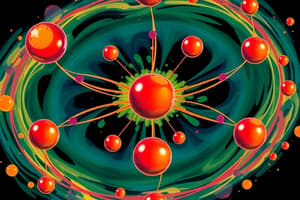Podcast
Questions and Answers
Which type of intermolecular force is present in all molecules, regardless of polarity?
Which type of intermolecular force is present in all molecules, regardless of polarity?
- Hydrogen bonding
- Ion-dipole forces
- Dipole-dipole forces
- London dispersion forces (correct)
Which type of intermolecular force is responsible for the attraction between oppositely charged ions in ionic compounds?
Which type of intermolecular force is responsible for the attraction between oppositely charged ions in ionic compounds?
- Hydrogen bonding
- Ionic forces (correct)
- Dipole-dipole forces
- London dispersion forces
Which of these factors influences the strength of London dispersion forces?
Which of these factors influences the strength of London dispersion forces?
- The polarity of the molecule
- The shape of the molecule
- The size of the molecule (correct)
- The presence of hydrogen bonds
Which type of intermolecular force is responsible for the unusually high boiling point of water compared to other similar molecules?
Which type of intermolecular force is responsible for the unusually high boiling point of water compared to other similar molecules?
Which statement accurately describes the relationship between kinetic energy and temperature?
Which statement accurately describes the relationship between kinetic energy and temperature?
Which of the following compounds is likely to exhibit hydrogen bonding?
Which of the following compounds is likely to exhibit hydrogen bonding?
Which of these intermolecular forces is considered the weakest?
Which of these intermolecular forces is considered the weakest?
Which type of intermolecular force is responsible for the solubility of polar molecules in water?
Which type of intermolecular force is responsible for the solubility of polar molecules in water?
Which of these is NOT a characteristic of intermolecular forces?
Which of these is NOT a characteristic of intermolecular forces?
Flashcards
Kinetic Molecular Theory
Kinetic Molecular Theory
Explains how molecules move in solid, liquid, and gas states.
Intermolecular Forces
Intermolecular Forces
Attractive forces that pull neighboring particles together.
Kinetic Energy
Kinetic Energy
Energy that keeps particles in motion or at a distance.
Ionic Compounds
Ionic Compounds
Signup and view all the flashcards
Covalent Compounds
Covalent Compounds
Signup and view all the flashcards
London Dispersion Forces
London Dispersion Forces
Signup and view all the flashcards
Dipole-Dipole Forces
Dipole-Dipole Forces
Signup and view all the flashcards
Hydrogen Bonds
Hydrogen Bonds
Signup and view all the flashcards
Ion-Dipole Forces
Ion-Dipole Forces
Signup and view all the flashcards
Study Notes
Kinetic Molecular Theory (KMT)
- KMT is a theory explaining how molecules move in different states of matter (solid, liquid, gas).
- Intermolecular forces are attractive forces between neighboring particles of one or more substances. These forces pull the particles together.
- Kinetic energy keeps particles at a distance and/or moving, and it's dependent on the temperature of the substance. Hotter substances have more kinetic energy.
- Intermolecular forces of attraction vary based on the type of compound.
- Ionic compounds have forces between oppositely charged particles (ions).
- Covalent compounds have weaker forces between neighboring molecules, as attraction involves partial charges.
Types of Intermolecular Forces
-
London Dispersion Forces:
- Also called dispersion forces, these are intermolecular forces of attraction between all atoms and molecules.
- They are the only forces in nonpolar molecules.
- Uneven electron distribution leads to temporary dipoles in atoms or molecules, causing an attraction to neighboring atoms/molecules.
-
Dipole-Dipole Forces:
- These forces occur between polar molecules.
- Polar molecules have unequal electron densities, resulting in a dipole (partial positive and partial negative ends).
- These partial charges attract each other.
- Forces of attraction are stronger in larger polar molecules due to larger dipoles.
-
Hydrogen Bonds:
- A special type of dipole-dipole interaction.
- Occurs in molecules with hydrogen bonded to a small, highly electronegative atom (N, O, or F).
- Strongest of the intermolecular forces.
-
Ion-Dipole Forces:
- Act between an ion (positive or negative) and a polar molecule.
- The ion is attracted to the oppositely charged end of the polar molecule.
Studying That Suits You
Use AI to generate personalized quizzes and flashcards to suit your learning preferences.




